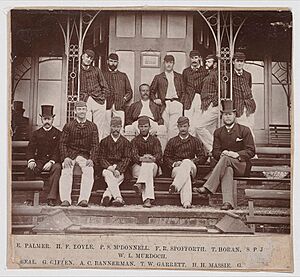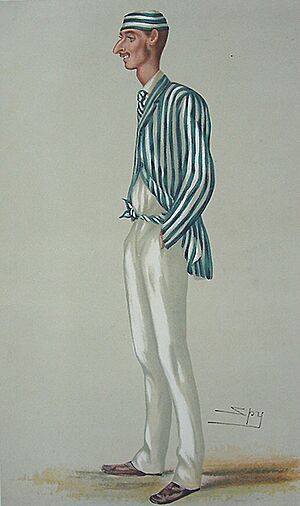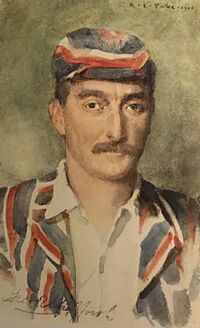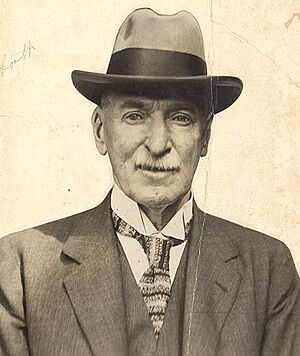Fred Spofforth facts for kids
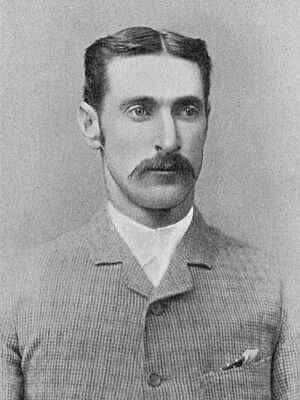
Spofforth in about 1897
|
||||||||||||||||||||||||||||||||||||||||
| Personal information | ||||||||||||||||||||||||||||||||||||||||
|---|---|---|---|---|---|---|---|---|---|---|---|---|---|---|---|---|---|---|---|---|---|---|---|---|---|---|---|---|---|---|---|---|---|---|---|---|---|---|---|---|
| Full name |
Frederick Robert Spofforth
|
|||||||||||||||||||||||||||||||||||||||
| Born | 9 September 1853 Balmain, New South Wales, Australia |
|||||||||||||||||||||||||||||||||||||||
| Died | 4 June 1926 (aged 72) Long Ditton, Surrey, England |
|||||||||||||||||||||||||||||||||||||||
| Nickname | The Demon Bowler | |||||||||||||||||||||||||||||||||||||||
| Height | 6 ft 3 in (1.91 m) | |||||||||||||||||||||||||||||||||||||||
| Batting | Right-handed | |||||||||||||||||||||||||||||||||||||||
| Bowling | Right arm fast-medium | |||||||||||||||||||||||||||||||||||||||
| Role | Bowler | |||||||||||||||||||||||||||||||||||||||
| International information | ||||||||||||||||||||||||||||||||||||||||
| National side | ||||||||||||||||||||||||||||||||||||||||
| Test debut (cap 14) | 31 March 1877 v England | |||||||||||||||||||||||||||||||||||||||
| Last Test | 31 January 1887 v England | |||||||||||||||||||||||||||||||||||||||
| Domestic team information | ||||||||||||||||||||||||||||||||||||||||
| Years | Team | |||||||||||||||||||||||||||||||||||||||
| 1874–1885 | New South Wales | |||||||||||||||||||||||||||||||||||||||
| 1885–1888 | Victoria | |||||||||||||||||||||||||||||||||||||||
| 1889–1891 | Derbyshire | |||||||||||||||||||||||||||||||||||||||
| Career statistics | ||||||||||||||||||||||||||||||||||||||||
|
||||||||||||||||||||||||||||||||||||||||
|
Source: Cricinfo, 25 March 2015
|
||||||||||||||||||||||||||||||||||||||||
Frederick Robert Spofforth (born September 9, 1853 – died June 4, 1926) was an Australian cricket player. He was known as "The Demon Bowler" because of his amazing skills. He was a fast bowler who played for Australia between 1877 and 1887.
Spofforth made history in cricket. He was the first bowler to take 50 wickets in Test matches. He also achieved the first ever Test hat-trick in 1879. Later in his life, he moved to England and played for Derbyshire. In 2009, he was honored by being added to the ICC Hall of Fame.
Contents
Early Life and Beginnings
Spofforth was born in Balmain, a suburb of Sydney, Australia. His father, Edward Spofforth, worked at the Bank of New South Wales. Fred spent some of his early years in Hokianga, New Zealand. He went to private schools in Sydney.
After finishing school, Spofforth worked as a clerk at the Bank of New South Wales.
Cricket Career in Australia
Fred Spofforth started bowling with an underarm style. But he changed his technique after watching English bowlers in 1863. He decided to master the overarm bowling action.
He first gained attention in 1874 while playing for New South Wales. He took two wickets against a strong English team led by W.G. Grace. Spofforth became a regular player for New South Wales.
First Test Match
Spofforth played his first Test match in 1877 in Melbourne. This was only the second Test match ever played. He took four wickets in the game against England. England won that match.
Becoming "The Demon Bowler"
Spofforth became famous on May 27, 1878. His Australian team played against the MCC at Lord's in England. The MCC team was very strong, but Spofforth's bowling was incredible. He helped dismiss them for very low scores of 33 and 19 runs.
The Australians won easily. Spofforth took 10 wickets for only 20 runs. After the game, he reportedly said, "Ain't I a demon?" This is how he got his famous nickname, "The Demon Bowler."
His performance showed the world how good Australian cricket was. Spofforth was known for staring at batsmen to try and scare them. This was a new tactic in the game.
The Ashes Series Begins
In 1882, Spofforth played a famous match at The Oval in England. England needed only 85 runs to win, but Spofforth told his team, "this thing can be done." He led his team to an amazing victory. Australia won by just seven runs. Spofforth took 14 wickets in that match.
This game was so important that it led to the creation of the legendary Ashes series. The Ashes is still a major cricket rivalry between Australia and England today.
Test Hat-Trick
In January 1879, Spofforth made history again. He became the first player to take a hat-trick in Test cricket. This means he took three wickets with three balls in a row. He dismissed three English batsmen in that match at the Melbourne Cricket Ground. He took 13 wickets in total during that game.
He also played in a game in Sydney in 1879 that led to a crowd disturbance, known as the Sydney riot of 1879.
Batting Skills
Even though he was famous for his bowling, Spofforth could bat too. In a Test match in 1884–85, he scored 50 runs. This was the highest score for Australia in that game, even though he batted at number eleven.
Fred Spofforth played his last Test match in Sydney in January 1887. He played for New South Wales from 1874 to 1885 and for Victoria from 1885 to 1887.
Life in England
In 1888, Spofforth moved to England and got married. He lived in Derbyshire. He wanted to play for the Derbyshire County Cricket Club. After waiting the required two years, he was able to play for them. In 1890, he even became the team captain.
Spofforth also played club cricket for Hampstead for many years. He continued to take many wickets for a low cost.
In England, he started a successful business as a tea-merchant. He became the managing director of the Star Tea Company, which belonged to his wife's family. He visited Australia several times and always kept an interest in cricket.
Spofforth passed away on June 4, 1926, in Long Ditton, England, due to an illness. He is buried in Brookwood Cemetery.
How He Bowled
Spofforth was tall and strong, standing 6 feet 3 inches (190.5 cm) tall. He started as a fast bowler. But later, he learned to bowl at medium-pace and even slow speeds. He was very good at hiding the speed of his ball. Batsmen found it hard to tell if he was bowling fast, medium, or slow.
He also discovered that on softer English cricket fields, his "break from the off" (now called "off-break") was better when he bowled slower. He used this skill to bowl out many batsmen. Out of his 94 wickets in Test matches, 50 were bowled out.
Spofforth might have also been the first to invent "swing bowling" (then called "swerve"). This is when the ball moves sideways in the air. He could make the ball curve inwards towards right-handed batsmen.
Even though his bowling average wasn't the lowest for his time, he always attacked the batsmen. Many people thought he was the best bowler in the game. He was especially good at bowling against W.G. Grace, who was the best batsman of that era.
In 1996, Fred Spofforth was added to the Australian Cricket Hall of Fame. A sculpture of him was unveiled at the Sydney Cricket Ground in 2008.
Images for kids


